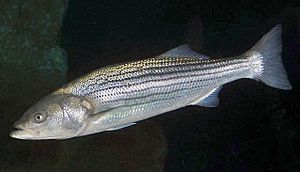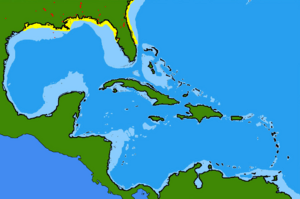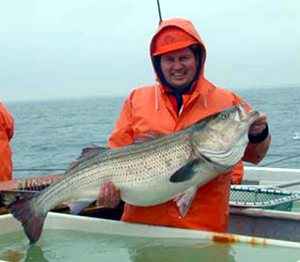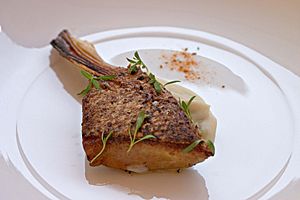Striped bass facts for kids
Quick facts for kids Striped bass |
|
|---|---|
 |
|
| Conservation status | |
| Scientific classification | |
| Genus: |
Morone
|
| Species: |
saxatilis
|
 |
|
| Southern coastal range in yellow (also further north along the Atlantic coast and inland in North America) | |
The striped bass (Morone saxatilis) is a cool fish found mostly along the Atlantic coast of North America. People also call it a linesider or rockfish because of the stripes on its body. This fish is special because it's anadromous, meaning it lives in both fresh and salt water.
Striped bass have been introduced to many places across the United States. This was done for fun fishing and to help control other fish populations. Some striped bass found in the Gulf of Mexico are a different kind.
This fish is so important that it's the official state fish for Maryland, Rhode Island, and South Carolina. It's also the state saltwater fish for New York, New Jersey, Virginia, and New Hampshire. People have been fishing for striped bass in North America for a very long time, even since the first European settlers arrived. They wrote about how many striped bass there were in the rivers back then!
Contents
Appearance and Life Cycle
The striped bass has a sleek, silver body with dark stripes running from its gills to its tail. It looks like a typical fish from its family.
Most adult striped bass weigh between 20 to 40 pounds (9 to 18 kg). The biggest one ever caught was 124 pounds (56 kg) in 1896! These fish can live for up to 30 years. On average, they are about 20 to 35 inches (50 to 89 cm) long and weigh 5 to 20 pounds (2 to 9 kg).
Where Striped Bass Live
Natural Homes
Striped bass naturally live along the Atlantic coast of North America. Their home stretches from the Saint Lawrence River all the way down to Louisiana in the Gulf of Mexico.
They are anadromous fish. This means they travel between fresh water and salt water. They always go back to fresh water to lay their eggs.
New Homes
People have moved striped bass to new places outside their natural range. This was done for two main reasons:
- To create more places for fun sport fishing.
- To help control populations of other fish, like gizzard shad, in large lakes and reservoirs.
You can now find striped bass in many big lakes across the United States. Some examples include Lake Ouachita in Arkansas, Lake Pleasant in Arizona, and Lake Texoma in Oklahoma.
They have also been introduced to countries like Ecuador, Mexico, and South Africa. This is mainly for sport fishing and fish farming.
Environment and Protection
The success of striped bass laying eggs can be affected by the water quality. For example, too many dissolved solids in the water can make it harder for them to reproduce. They can live in lakes, ponds, streams, and wetlands.
In the past, the number of striped bass grew quickly in the 1980s and 1990s. However, this big population started eating too many of their prey fish, like river herring and shad. This put the striped bass population at risk because their food source was shrinking.
To protect them, the United States made the striped bass a protected game fish in 2007. This means it's against the law to sell striped bass caught in federal waters along the Atlantic coast and Gulf of Mexico.
In Canada, the striped bass population in the Saint Lawrence River disappeared by 1996. This was likely due to too much fishing and dredging (digging up the riverbed). But a program to bring them back started in 2002 and has been successful!
Reproduction and Life Cycle
Striped bass lay their eggs in fresh water. Even though some have learned to live only in fresh water, they naturally spend their adult lives in salt water.
Some important places where striped bass breed are:
The Chesapeake Bay is one of the biggest breeding areas. Many rivers and streams that flow into the Atlantic used to have breeding striped bass until the 1860s.
A few places have freshwater striped bass that can reproduce on their own. These include Lake Texoma, the Colorado River, and the Arkansas River. Most other freshwater striped bass populations need new fish added from hatcheries every year.
Hybrid Bass
Striped bass can be bred with other fish, like white bass. This creates a new kind of fish called a hybrid striped bass. These hybrids are also known as wiper or sunshine bass. They are often put into freshwater lakes across the U.S. for fishing.
Fishing for Striped Bass
Striped bass are very popular for sport fishing. People use many different ways to catch them. Some popular methods include:
- Trolling: Pulling lures behind a boat.
- Surf casting: Casting from the beach, often with lures that float on the surface.
- Bait casting: Using live or dead bait.
Striped bass will eat many kinds of bait, like bunker, clams, eels, and herring.
The biggest striped bass ever caught by a fisherman weighed 81.88 pounds (37.14 kg)! It was caught in Long Island Sound, Connecticut, in 2011 by Gregory Myerson. It took him 20 minutes to reel in the huge fish. This fish was 54 inches (137 cm) long!
The rules for how many striped bass a person can catch vary by state.
Landlocked Striped Bass
Since striped bass travel up rivers to lay eggs, some got "landlocked" when dams were built. This happened at the Santee-Cooper River in South Carolina. Because of this, the striped bass is South Carolina's state game fish.
Biologists now think that some striped bass stay in rivers for a long time. They might not go back to the sea unless the water temperature changes. When fishermen and scientists noticed more striped bass in lakes, many states started stocking them there.
Even landlocked striped bass try to swim upstream to lay eggs during spawning season. It's hard for them to reproduce naturally in lakes. One of the most successful places where landlocked striped bass reproduce on their own is the Coosa River in Alabama and Georgia.
A huge landlocked bass weighing 70.6 pounds (32.0 kg) was caught in Alabama in 2013. This is a world record for a landlocked bass!
Managing Striped Bass
The number of striped bass dropped to less than 5 million by 1982. But thanks to efforts by fishermen (who released smaller fish) and special programs, the population grew back. By 2007, there were almost 56 million fish!
In 2006, fishermen caught a record 3.8 million striped bass. To manage the species, there are rules about:
- How big a fish must be to keep it.
- How many fish commercial fishermen can catch.
- Healthy population goals for the species.
In 2019, experts found that the striped bass population was being overfished. This led to some states closing the trophy fishing season to help the fish recover. Another way to help them is to bring them back to their original spawning areas in coastal rivers.
Striped Bass as Food
| Nutritional value per 100 g (3.5 oz) | |
|---|---|
| Energy | 461 kJ (110 kcal) |
|
0 g
|
|
|
3 g
|
|
| Saturated | 1 g |
| Polyunsaturated |
0.8 g
|
|
Protein
|
19 g
|
| Minerals | Quantity
%DV†
|
| Sodium |
5%
75 mg |
|
Source: Seafood Nutrition Chart, New York Sea Grant and the New York Seafood Council, 1996.
|
|
| †Percentages estimated using US recommendations for adults. | |
Striped bass has white meat that tastes mild and has a medium texture. It's a very flexible fish to cook! You can:
- Pan-sear it
- Grill it
- Steam it
- Roast it
- Broil it
- Sauté it
- Deep fry it
You can also eat the meat raw or pickled.
You can buy fresh striped bass all year round. It's usually sold whole, as fillets (boneless pieces), or as loins. It's a popular fish in beach towns because it's easy to grill.
See also
 In Spanish: Lubina rayada atlántica para niños
In Spanish: Lubina rayada atlántica para niños







